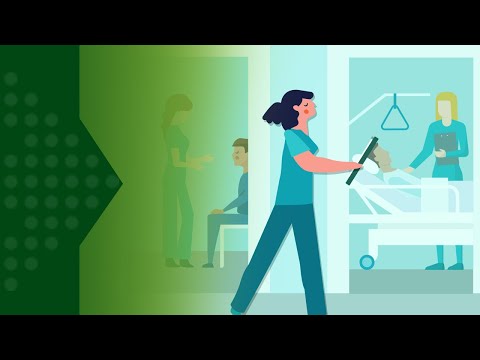What Does a Medical Assistant Do?
Contents
Considering a career as a Medical Assistant? Here’s everything you need to know about what they do, the training required, and the job outlook.
Checkout this video:
Job Description
A medical assistant is a multi-skilled professional who supports the work of physicians and other health professionals, usually in an outpatient clinic. Medical assistants perform a variety of administrative and clinical duties, including taking and recording medical histories and vital signs, preparing patients for examination, scheduling appointments, arranging for hospital admission and laboratory services, handling correspondence, billing patients, and filing insurance claims. They also may collect blood and tissue samples for laboratory analysis and perform basic laboratory tests on the premises. Some medical assistants take X rays.
Duties and Responsibilities
Medical assistants perform many duties and responsibilities to help keep doctors’ offices, clinics, and other healthcare facilities running smoothly. Depending on the size and location of the facility, medical assistants may have more or less responsibility. In small facilities, medical assistants may do everything from scheduling appointments and updating medical records to taking X-rays and giving injections. In larger facilities, medical assistants usually specialize in one or two areas of responsibility.
The duties and responsibilities of medical assistants typically include:
Answering patients’ questions
Scheduling appointments
Updating and filing patients’ medical records
Taking vital signs, such as blood pressure or temperature
Drawing blood
Preparing patients for examination
Assisting the physician during the examination
Giving injections
collecting lab specimens
Administering medications as directed by a physician
instructions to patients on various aspects of health care
Salary and Job Outlook
The median annual salary for medical assistants was $34,800 in May 2019, and the job outlook is projected to grow by 23% from 2019-2029, much faster than the average for all occupations. Employment of medical assistants is expected to grow because of the increasing number of aging baby boomers and their greater demand for health care services. Medical assistants play a vital role in the health care industry by performing both clinical and administrative tasks. Most medical assistants have postsecondary education such as a certificate, although some have an associate’s degree.
Education and Training
Most medical assistants have postsecondary education such as a certificate. Some programs take as little as 4 months to complete, but most take 1 year or longer. A small number of people with long-term, on-the-job training also qualify. Some states have formal certification programs for medical assistants.
Employers prefer to hire candidates who have graduated from formal medical assisting programs and who are certified. Certification demonstrates mastery of the material and indicates a commitment to quality patient care. Most certified medical assistants have completed postsecondary education, although some states allow candidates to take the certification exam without completing an educational program.
Skills and Qualifications
Medical assistants must have a keen eye for detail, excellent organizational skills, and superb customer service abilities. Additionally, medical assistants should be proficient in Medical Terminology and have strong written and verbal communication skills. Although some employers may require postsecondary education, many will provide on-the-job training for those with a high school diploma or its equivalent. Some states also require certification.
Certification
There are many different types of medical assistants, each with their own set of responsibilities. In order to become a certified medical assistant, you must complete an accredited training program and pass a certification exam.
Medical assistants can be certified as either general or specialized members of the medical team. General medical assistants typically perform administrative and clinical tasks, while specialized medical assistants have more specific roles such as working in a lab or performing X-rays.
Advancement Opportunities
There are many opportunities for advancement for medical assistants. With experience, medical assistants may be promoted to office manager or other supervisory positions. Some medical assistants become certified medical assistants. A certified medical assistant is a medical assistant who has passed a standardized exam administered by an accredited organization, such as the American Association of Medical Assistants or the National Healthcare Association.
Some states require certification for all medical assistants, regardless of experience. In some states, certification may allow a medical assistant to perform additional tasks, such as giving injections or handling medications. Certification may also be required for certain advanced positions, such as surgical assistant or operating room technician.
Work Schedule
Most medical assistants work full time, although about 1 in 4 worked part time in 2016. Because many medical offices are open during evenings and weekends, some medical assistants work those hours. Many medical assistants have evening or weekend shifts, or rotating shifts. A small number of medical assistants work overnight shifts. Some medical assistants may work in more than one office; travel to different locations during the day to provide care; or have shifts at more than one facility, such as a nursing home and a hospital.
Pros and Cons
There are pros and cons to everything in life and a career as a medical assistant is no different. It’s important that you consider both the positive and negative aspects of the job before making your decision.
Let’s start with the pros:
One of the biggest advantages to being a medical assistant is the job outlook. The Bureau of Labor Statistics predicts that employment in this field will grow by 29% from 2016 to 2026, which is much faster than average. This growth is due, in part, to an aging population who will need more medical care as they age.
Another big pro is the salary. The median annual salary for medical assistants was $32,480 in 2016, which means that half of all medical assistants earned more than this amount and half earned less.
The next advantage is that you don’t need a lot of training to become a medical assistant. Most programs can be completed in less than two years and many employers will provide on-the-job training. This makes it a great option if you’re looking for a new career but don’t have the time or money to invest in a four-year degree.
The last pro is that you can work in a variety of settings as a medical assistant. You can work in a doctor’s office, clinic, hospital or even an insurance company. This flexibility is great if you like to change things up or if you need to move for personal reasons.
Now let’s look at the cons:
One of the biggest disadvantages to being a medical assistant is that it can be a stressful job. You will be working with sick people and dealing with sometimes life-and-death situations. If you don’t have strong coping skills, this may not be the right career for you.
Another con is that some people view medical assistants as “second-class” citizens within the healthcare system. This isn’t always true, but there are some doctors and nurses who look down on medical assistants because they didn’t go to medical school themselves.
The last con is that medical assistants don’t have a lot of room for advancement within their career. If you want to move up, you will likely have to go back to school to become a registered nurse or doctor.
So those are some of the pros and cons of being a medical assistant. As with any career choice, it’s important that you do your research and make sure it’s the right fit for you before making any decisions.
FAQs
If you’re considering a career in healthcare, you may be wondering what exactly a medical assistant does. Medical assistants perform a variety of administrative and clinical tasks to support the work of physicians and other health professionals.
Medical assistants are usually divided into two categories: administrative and clinical. Administrative medical assistants are responsible for greeting patients, scheduling appointments, handling billing and insurance matters, and maintaining Medical records Clinical medical assistants may take vital signs, prepare patients for examination, assist with office procedures, give injections, perform phlebotomy — the list goes on. In some states, they may even be allowed to prescribe medications under the supervision of a licensed physician.
The best way to learn about the day-to-day responsibilities of a medical assistant is to shadow someone who is already working in the field. If you know a medical assistant who would be willing to let you tag along for a day or two, that’s ideal. If not, many schools offering medical assistant programs offer shadowing opportunities as well.







